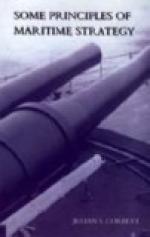Take the first, which, in spite of all the deductions we have to make from it in the case of limited wars, is the dominating one. The pithy maxim which expresses its essence is that our primary objective is the enemy’s main force. In current naval literature the maxim is applied to the sea in some such form as this: “The primary object of our battle-fleet is to seek out and destroy that of the enemy.” On the surface nothing could look sounder, but what are the conditions which underlie the one and the other?
The practical value of the military maxim is based upon the fact that in land warfare it is always theoretically possible to strike at your enemy’s army, that is, if you have the strength and spirit to overcome the obstacles and face the risks. But at sea this is not so. In naval warfare we have a far-reaching fact which is entirely unknown on land. It is simply this—that it is possible for your enemy to remove his fleet from the board altogether. He may withdraw it into a defended port, where it is absolutely out of your reach without the assistance of an army. No amount of naval force, and no amount of offensive spirit, can avail you. The result is that in naval warfare an embarrassing dilemma tends to assert itself. If you are in a superiority that justifies a vigorous offensive and prompts you to seek out your enemy with a view to a decision, the chances are you will find him in a position where you cannot touch him. Your offence is arrested, and you find yourself in what, at least theoretically, is the weakest general position known to war.
This was one of our earliest discoveries in strategy. It followed indeed immediately and inevitably upon our discovery that the most drastic way of making war was to concentrate every effort on the enemy’s armed forces. In dealing with the theory of war in general a caveat has already been entered against the too common assumption that this method was an invention of Napoleon’s or Frederick’s, or that it was a foreign importation at all. In the view at least of our own military historians the idea was born in our Civil Wars with Cromwell and the New Model Army. It was the conspicuous feature that distinguished our Civil War from all previous wars of modern times. So astonishing was its success—as foreign observers remarked—that it was naturally applied by our soldier-admirals at sea so soon as war broke out with the Dutch. Whatever may be the claims of the Cromwellian soldiers to have invented for land warfare what is regarded abroad as the chief characteristic of the Napoleonic method, it is beyond doubt that they deserve the credit of it at sea. All three Dutch wars had a commercial object, and yet after the first campaign the general idea never was to make the enemy’s commerce a primary objective. That place was occupied throughout by their battle-fleets, and under Monk and Rupert at least those objectives were pursued with a singleness of purpose and a persistent vehemence that was entirely Napoleonic.




